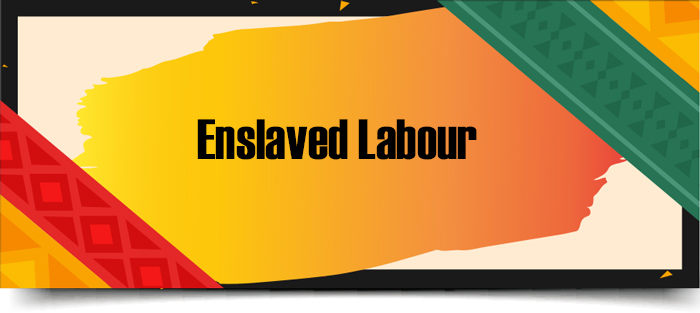
Previous | Exhibit Home | Next
The enslaved population spread across Southern Ontario in both rural and urban areas. Enslaved peoples were made to perform many tasks to aid in settlement and in the operation of households, farms, and businesses. The roles for enslaved men and women would also vary. Enslavers also benefitted from the labour of the people they enslaved by collecting wages for the work of enslaved people who were hired or rented out. The increased production and sustainability due to the use of enslaved labour compared to settlers who did not use enslaved labour was evident. The settler households that enslaved Black and Indigenous people cultivated more land and produced more yield than their non-slaveholding neighbours.
Enslaved men often performed physically demanding jobs. They cleared land, chopped wood, and built structures like homes and barns on their enslaver’s property. Many helped to establish and operate family farms. Enslaved men also worked as hunters, voyageurs, sailors, miners, fishermen, and dockside workers. They also commonly laboured as craftsman in skilled trades as blacksmiths, carpenters, and coopers.
Enslaved women performed a variety of household chores such cooking, churning butter, washing laundry, hairdressing, making candles and soap, milking cows, and making preserves. They also fetched clean water, gathered firewood, sewed, knitted, carded wool, washed pots, pans, and dishes, swept and dusted. Enslaved women provided personal care services like bathing and dressing. One key role was taking care of their enslaver’s children.
Both enslaved women and men served families and guests. They prepared fields for planting, helped to produce staple crops that could be grown in this climate, harvested the crops, and tended to livestock such as chickens, horses, cows, sheep, and pigs.
Many enslaved women and men laboured alongside their enslavers in the businesses they operated, including skilled trades shops, merchant stores, mills, inns and taverns.
The coerced labour of enslaved men, women, and children contributed to the development of early Upper Canada.
Enslaved Children
Almost one quarter of the enslaved population in Upper Canada were children. Enslaved Black children inherited their unfree status from their mothers according to the law and by custom. Black children held in bondage were financial assets for their enslavers. The labour they performed from the time that they were put to work at a young age helped to generate profit and comfort. Enslaved Black children were expected to perform some level of labour as soon as they could walk firmly and lift and carry things. They typically began their forced labour working alongside their mothers. Their lives revolved around work. As chattel, they were viewed outside of the western construction of children of the time. As they got older, the monetary value of enslaved children usually increased. Enslaved young males were trained to do farm work and skilled tasks as well as serve as manservants while females were trained in domestic service and farming duties.
In 1788, Physician Samuel Jones of Augusta Township purchased eight-year-old Elizabeth from his brother Daniel Jones, whose trading included trafficking enslaved people.
![Bill of sale of an eight-year old enslaved Black girl named Elizabeth [1778] A handwritten agreement, ink on paper](../../../../images/slavery_uppercanada/enslaved_labour/Bill of sale.jpg)
Click to see a larger image
Bill of sale of an eight-year-old enslaved Black girl named Elizabeth, [1778]
Ink on paper
Ontario Heritage Trust, 983.18.9
|
“…that I Daniel Jones of Oswegatchie Settlement district of Montreal Province of Quebec in consideration of the sum of twenty five pound Halifax currency to me in hand paid by Solomon Jones in same Settlement District and Province aforesaid and I do hereby acknowledge myself truly satisfied contented and paid by this presents do sell bargain convey and deliver unto the aforesaid Solomon Jones a negro girl named Elizabeth about eight years old to have and to hold the said negro girl forever to only proper use and behalf of him the said Solomon Jones his heirs Executors Administrators and Assigns forever and I Daniel Jones for myself Executors Administrators and Assigns do and will for ever warrant and defend the sale by their presents In witness whereof I have herewith interchangeably set my hand this 30th day of August at Augusta Anno Domino 1788” Daniel Jones in presence of Richard Jones |
Elizabeth
Elizabeth was enslaved in Augusta Township by Dr. Solomon Jones. She appears to have been the only enslaved person in the Jones household. Elizabeth was alone, without any family. As an enslaved female child, Elizabeth was forced to do various duties. She would have been a companion and caretaker to the young Jones children at the time. She would have attended to both Mrs. Jones the wife and Mrs. Jones the widowed mother. As a lady’s maid or housemaid, she likely fetched firewood, gathered eggs and garden harvests, carried fresh water to the rooms of Jones family members, emptied dirty water, and emptied and rinsed chamber pots. She would have done sweeping, dusting, cleaning and tidying. Her duties would have increased as she got older.
